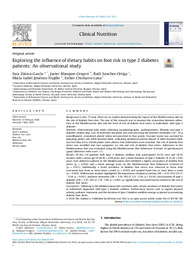Título :
Exploring the influence of dietary habits on foot risk in type 2 diabetes patients: An observational study |
Autor :
Zúnica García, Sara 
Blanquer Gregori, José Javier 
Sanchez-Ortiga, Ruth 
Jiménez-Trujillo, Isabel 
Chicharro-Luna, Esther  |
Editor :
Elsevier |
Departamento:
Departamentos de la UMH::Ciencias del Comportamiento y salud |
Fecha de publicación:
2024-06 |
URI :
https://hdl.handle.net/11000/37449 |
Resumen :
Background & aim: To date, there are no studies demonstrating the impact of the Mediterranean diet on
the risk of diabetic foot ulcer. The aim of this research was to examine the connection between adherence
to the Mediterranean diet and the level of risk of diabetic foot ulcers in individuals with type 2
diabetes.
Methods: Observational pilot study collecting sociodemographic, anthropometric, lifestyle, and type 2
diabetes-related data. Loss of protective sensation was assessed using the Semmes Weinstein 5.07e10 g
monofilament, considered altered when not perceived in four points. Vascular status was assessed by
palpating pulses and ankle-brachial index, indicating peripheral arterial disease if ankle-brachial index
was less than 0.9 or if both pulses were absent. Foot deformities were recorded. The risk of diabetic foot
ulcers was stratified into two categories: no risk and risk of diabetic foot ulcers. Adherence to the
Mediterranean diet was evaluated using the Mediterranean Diet Adherence Screener-14 questionnaire
(good adherence with score >7).
Results: Of the 174 patients with type 2 diabetes mellitus who participated (61.5% men and 38.5%
women) with a mean age of 69.56 ± 8.86 years and a mean duration of type 2 diabetes of 15.34 ± 9.83
years. Non-adherent patients to the Mediterranean diet exhibited a higher association of diabetic foot
ulcers (p ¼ 0.030) and a lower average score on the Mediterranean Diet Adherence Screener-14
(p ¼ 0.011). Additionally, a lower incidence of diabetic foot ulcers was observed in those who
consumed nuts three or more times a week (p ¼ 0.003) and saut eed foods two or more times a week
(p ¼ 0.003). Multivariate analysis highlighted the importance of physical activity (OR ¼ 0.25, 95% CI 0.11
e0.54; p < 0.001), podiatric treatment (OR ¼ 2.59, 95% CI 1.21e5.56; p ¼ 0.014), and duration of type 2
diabetes (OR ¼ 3.25, 95% CI 1.76e5.99; p < 0.001) as significantly associated factors related to the risk of
diabetic foot ulcers.
Conclusions: Adhering to the Mediterranean diet correlates with a lower incidence of diabetic foot ulcers
in individuals diagnosed with type 2 diabetes mellitus. Furthermore, factors such as regular physical
activity, podiatric treatment, and the duration of type 2 diabetes mellitus emerge as pivotal in preventing
diabetic foot ulcers.
|
Palabras clave/Materias:
Type 2 diabetes
Diabetic foot ulcer
Foot risk
Mediterranean diet
Adherence
Dietary habits |
Área de conocimiento :
CDU: Ciencias aplicadas: Medicina |
Tipo de documento :
info:eu-repo/semantics/article |
Derechos de acceso:
info:eu-repo/semantics/openAccess |
DOI :
https://doi.org/10.1016/j.clnu.2024.05.005 |
Publicado en:
Clinical Nutrition, Volume 43, Issue 6, June 2024, Pages 1516-1521 |
Aparece en las colecciones:
Artículos Ciencias del Comportamiento y Salud
|

 La licencia se describe como: Atribución-NonComercial-NoDerivada 4.0 Internacional.
La licencia se describe como: Atribución-NonComercial-NoDerivada 4.0 Internacional.
.png)